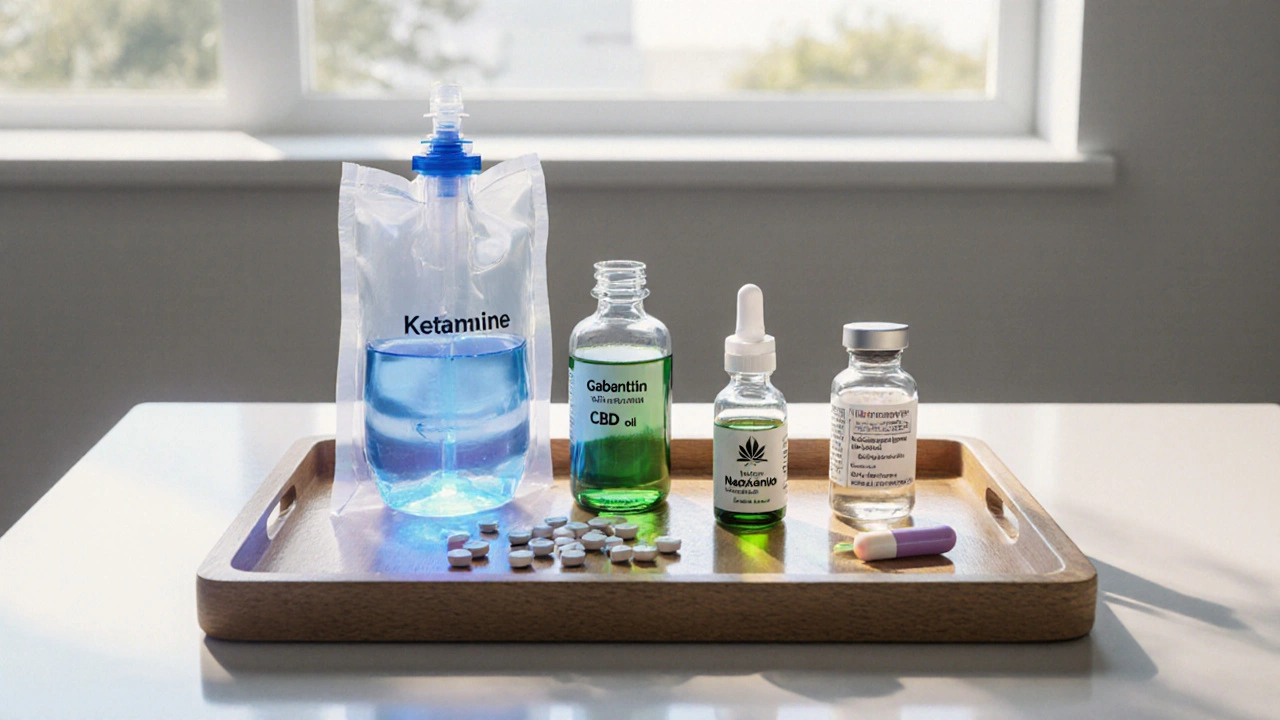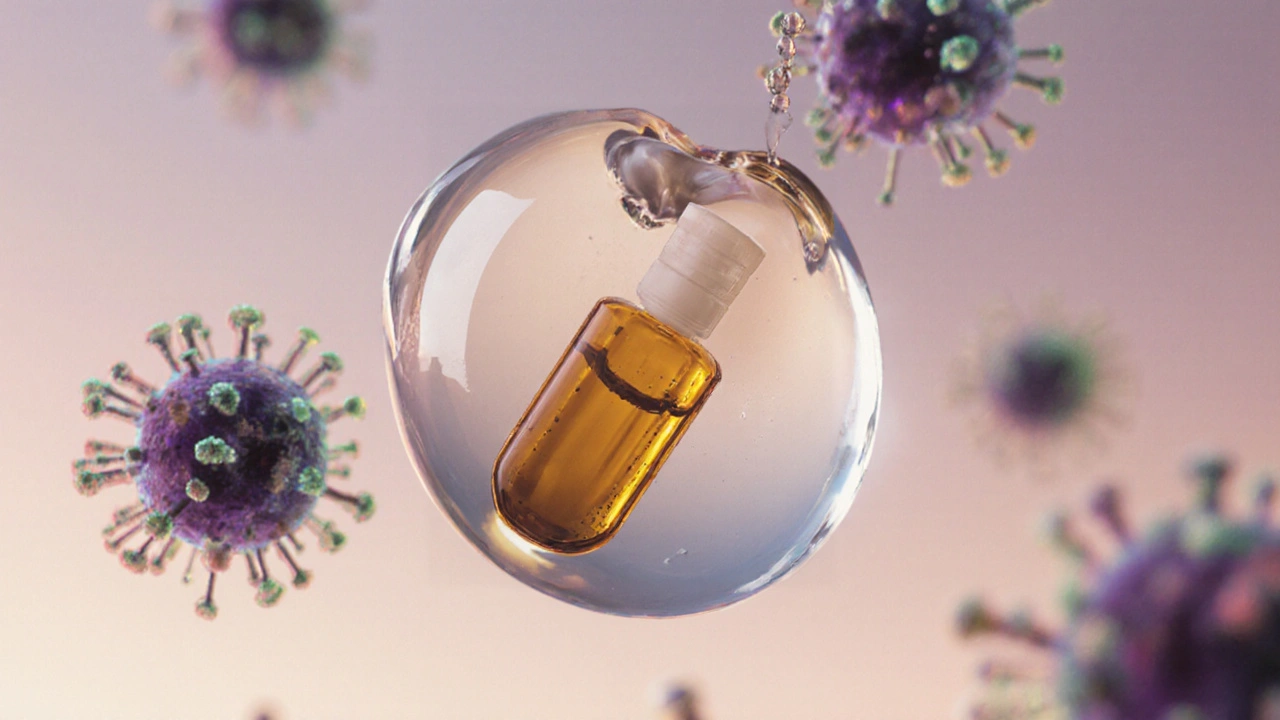LDN Alternative Selector
Recommended Alternative:
Quick Summary / Key Takeaways
- Low‑Dose Naltrexone (LDN) modulates the immune system and helps with chronic pain, but it isn’t suitable for everyone.
- Ketamine, gabapentin, cannabidiol (CBD) and low‑dose naloxone are the most commonly discussed substitutes.
- When choosing an alternative, consider mechanism of action, evidence strength, side‑effect profile, cost and how easy it is to obtain.
- For autoimmune conditions, LDN and low‑dose naloxone rank highest on safety; for severe neuropathic pain, ketamine often outperforms.
- Always discuss any switch with a healthcare professional familiar with off‑label use.
What is Low‑Dose Naltrexone?
When you see LDN is a low‑dose formulation of the opioid antagonist naltrexone, typically 1.5‑4.5mg per day, used off‑label to modulate the immune system and reduce chronic pain. It was originally approved at 50mg for alcohol and opioid dependence, but researchers discovered that a tiny dose triggers a brief opioid‑receptor blockade followed by a rebound increase in endorphin production. That rebound is thought to reset immune signaling and dampen inflammation.
Why Look for Alternatives?
Not everyone can tolerate LDN. Some people experience vivid dreams, liver enzyme spikes, or simply don’t feel any benefit after several weeks. Insurance coverage is patchy, and pharmacies may not stock the tiny capsules needed. If you’ve hit a wall with LDN, it makes sense to explore other options that target the same pathways or provide complementary relief.

How to Compare Alternatives
Before you jump into a new regimen, ask yourself these questions:
- Mechanism of action: Does the drug work by modulating immune pathways, altering neurotransmitters, or both?
- Evidence strength: Are there randomized controlled trials (RCTs), observational studies, or just anecdotal reports?
- Side‑effect profile: Which adverse reactions are common and how severe are they?
- Cost & availability: Is the medication covered by insurance, and can you get it locally?
- Condition match: Is the drug proven for the specific autoimmune or pain condition you’re managing?
Top Alternatives to LDN
Below are the most frequently mentioned substitutes, each with a brief snapshot of how it stacks up against LDN.
Ketamine is a NMDA‑receptor antagonist that provides rapid analgesia and anti‑depressive effects, often used in low‑dose infusion clinics for chronic pain and treatment‑resistant depression.
Ketamine’s biggest draw is speed-patients can notice pain relief within hours. However, it requires supervised infusions or a prescription for a nasal spray (esketamine), and long‑term safety data are still emerging.
Gabapentin is a gabapentinoid that stabilizes neuronal membranes and reduces excitatory neurotransmitter release, widely prescribed for neuropathic pain and seizures.
It’s inexpensive and often covered by insurance, but dosing can be high (up to 3,600mg/day) and side effects like dizziness, weight gain and edema are common.
Cannabidiol (CBD) is a non‑psychoactive cannabinoid extracted from hemp that interacts with the endocannabinoid system, showing modest anti‑inflammatory and analgesic properties.
CBD is legal in many regions and comes in oils, capsules, or topical creams. Product quality varies wildly, and the evidence for autoimmune disease is still limited.
Low‑Dose Naloxone is a short‑acting opioid antagonist similar to naltrexone but with a shorter half‑life, sometimes used in ultra‑low doses to modulate opioid receptors without triggering withdrawal.
Research on low‑dose naloxone for immune modulation is nascent, but early pilot studies suggest a safety profile comparable to LDN and a potentially quicker titration curve.
Dronabinol is a synthetic THC approved for appetite stimulation and nausea, occasionally repurposed off‑label for pain and spasticity.
Because it activates CB1 receptors, dronabinol can cause sedation and psychoactive effects, making it less appealing for daytime use.
Side‑by‑Side Comparison
| Attribute | LDN (Naltrexone) | Ketamine | Gabapentin | CBD | Low‑Dose Naloxone |
|---|---|---|---|---|---|
| Primary Mechanism | Opioid‑receptor blockade → endorphin rebound (immunomodulation) | NMDA‑receptor antagonism (rapid analgesia) | Calcium channel modulation (neuropathic pain) | Endocannabinoid system interaction (anti‑inflammatory) | Short‑acting opioid antagonism (endorphin modulation) |
| Typical Dose | 1.5‑4.5mg daily | 0.5‑1mg/kg IV infusion or 28mg nasal spray (esketamine) | 300‑3,600mg divided BID | 10‑50mg twice daily (oil) | 0.125‑0.5mg daily |
| Evidence Strength | Medium - several RCTs in MS, Crohn’s, fibromyalgia | High for acute pain; emerging for chronic pain | High - decades of use, many RCTs | Low‑medium - small trials, many anecdotal reports | Low - pilot studies only |
| Common Indications | Autoimmune disease, chronic pain, fatigue | Severe neuropathic pain, depression | Neuropathic pain, post‑herpetic neuralgia | Inflammatory arthritis, anxiety, sleep aid | Autoimmune flare, chronic pain (off‑label) |
| Typical Side Effects | Sleep disturbances, vivid dreams, mild liver enzyme rise | Dissociation, blood pressure spikes, nausea | Dizziness, edema, weight gain | Dry mouth, drowsiness, GI upset | Rare - mild headache, transient nausea |
| Cost & Access | Low‑cost compounding; limited insurance coverage | High - infusion clinic fees or prescription‑only nasal spray | Very low, widely covered | Variable - OTC products can be pricey | Very low, often available as generic naloxone |

Choosing the Right Substitute for Your Situation
Here’s a quick guide to match your primary goal with the most suitable alternative.
- Autoimmune flare with mild pain: Stick with LDN or try low‑dose naloxone-both have the cleanest safety record.
- Severe neuropathic pain that hasn’t responded to gabapentin: Consider a ketamine infusion; the rapid effect can break a pain cycle.
- Budget‑conscious neuropathy: Gabapentin remains the most cost‑effective first line.
- Desire for natural‑derived product and fewer drug interactions: CBD oil may be worth a trial, especially if you already use other supplements.
- Concern about psychoactive side effects: Low‑dose naloxone or LDN are non‑psychoactive, while ketamine and dronabinol are not.
Safety Tips and Common Pitfalls
Switching or adding a new agent can trigger unexpected reactions. Keep these points in mind:
- Start low and titrate slowly. Even “low‑dose” medications can cause a sudden spike in side effects if you jump to the top dose.
- Watch liver function tests if you stay on LDN or switch to another opioid antagonist.
- Never mix multiple opioid antagonists without medical supervision - it can blunt the effect of any pain meds you’re still taking.
- Document your symptoms daily. A simple spreadsheet helps you see whether the new drug actually improves pain scores or just adds a new side effect.
- Check insurance formulary before committing to an expensive ketamine infusion or branded CBD product.
Talking to Your Healthcare Provider
Bring a one‑page cheat sheet that includes:
- Name and dose of the current LDN regimen.
- Reason you’re considering a change (e.g., side effects, cost, lack of benefit).
- Preferred alternative(s) and why you think they fit your needs.
- Any recent lab results, especially liver enzymes.
A collaborative discussion lets the clinician adjust taper schedules, monitor labs, and possibly combine low‑dose therapies safely.
Frequently Asked Questions
Can I take LDN and gabapentin together?
Yes, they work via different pathways and are often combined for neuropathic pain. Start gabapentin at a low dose and monitor for dizziness.
Is low‑dose naloxone truly effective for autoimmune disease?
Evidence is still early‑stage-small pilot trials show modest reductions in flare frequency, but larger RCTs are needed before it becomes a standard option.
Why do some people report vivid dreams on LDN?
The brief opioid‑receptor blockade triggers a surge of endogenous opioids that affect REM sleep, leading to more vivid or memorable dreams. Taking LDN at bedtime can accentuate this effect.
Is CBD legal to use for pain relief in New Zealand?
Yes, CBD products containing less than 0.3% THC are legal to purchase over the counter, but clinicians advise checking the product’s third‑party lab results for purity.
How quickly can I expect pain relief from ketamine?
Many patients notice a reduction in pain within 30minutes to a few hours after an infusion. The effect can last several days, but repeat sessions are usually needed for chronic conditions.



When you’re weighing LDN against the other options, think of it like a toolbox: each tool has its own sweet spot. For mild autoimmune flares, LDN’s safety profile makes it a solid first‑line choice. If cost is a major concern, gabapentin often wins the price‑competitiveness race. On the other hand, severe neuropathic pain may need something with a quicker punch, like ketamine. And remember, always loop in your clinician before swapping anything out.
Behold! The battlefield of drugs where heroes clash and only the bold survive-LDN versus the legion of alternatives! If you crave the fire‑breathing dragon of rapid relief, summon Ketamine! For the thrifty pilgrim, Gabapentin is your humble steed. And should you desire the green‑kissed charm of nature, let CBD whisper its mystical promises.
Hey folks 😊, just wanted to add that mixing LDN with a low‑dose naloxone can sometimes give you a smoother taper if the dreams get too vivid. I’ve seen patients keep their liver enzymes stable by checking labs every few months. Also, keep a daily pain journal-tiny patterns pop up that you might miss otherwise.
Philosophically speaking, the pursuit of pain relief mirrors the quest for truth: you must interrogate each hypothesis with rigor. LDN offers a modest but elegant mechanism-brief opioid antagonism leading to endorphin rebound-yet its evidentiary weight is merely medium. Ketamine, conversely, provides a high‑impact, high‑risk solution, demanding supervised administration. The cost‑effective gabapentin, while abundant, brings a cascade of side effects that can undermine quality of life. CBD’s allure lies in its natural veneer, but the scientific community still wrestles with inconclusive data. Low‑dose naloxone flirts with promise, yet remains a fledgling contender awaiting robust trials. Ultimately, your selection should be guided by the hierarchy of safety, efficacy, and personal values.
Sure, because everybody loves spending a fortune on mystery herbs.
LDN is safe. Ketamine works fast. Gabapentin cheap. CBD natural. Low‑dose naloxone new.
Wow, what a rollercoaster of options-if you’re not careful you’ll end up with a pharmacy on speed dial and a therapist in your contacts. Seriously, though, I love that the table breaks down pros and cons, saves you from scrolling endless forums.